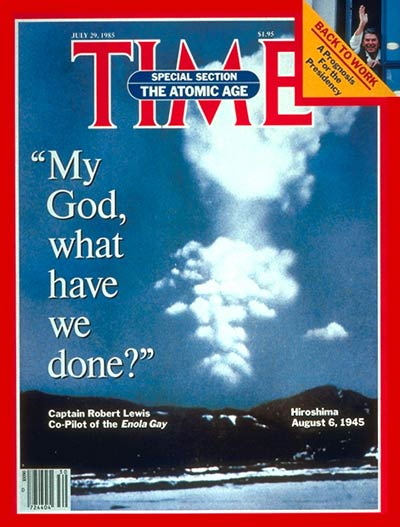
On Aug. 6, 1945, the United States dropped the world’s first atomic bomb on the Japanese city of Hiroshima. Combined with a similar nuclear strike on Nagasaki on Aug. 9, the attacks helped lead to Japan’s surrender during World War II and the end of the conflict in the Pacific—and decades’ worth of debate over the choice.
Here are seven TIME stories about the devastation and the implications of the decision to bomb the cities.
Marching orders: See the operations orders given to Jacob Beser, the electronics specialist who had to make sure radio waves didn’t interfere with the device and “the only man to fly both atomic bomb missions.” These military documents are now part of the collection of The Museum of World War II in Natick, Mass.
The first reaction: The Aug. 20, 1945, issue of TIME—published just after that infamous week—not only explained who developed the technology and how it worked, but also how it would change diplomacy forever:
The atomic bomb was not merely a new weapon; it was a new dimension of military and political power. Each in its turn, steel and gunpowder and aircraft had gradually changed war and society. In a single day the atomic bomb made a bigger change than any of them. Its blast hit every war office and chancellery on earth.
An eyewitness account: As part of TIME’s July 29, 1985, cover package for the 40th anniversary of the bombings, Yoshitaka Kawamoto, the director of the Hiroshima Peace Memorial Museum, described what it was like to be 13 years old and attending school near the site on that day:
…We were taught that it was cowardly to desert one’s classmates. So I crawled about the rubble, calling, ‘Is there anyone alive?’
I saw an arm shifting under planks of wood. Ota, my friend, was moving. But I could see that his back was broken, and I had to pull him up into the clear. Ota was looking at me with his left eye. His right eyeball was hanging from his face. I think he said something, but I could not make it out. Pieces of nails were stuck on his lips. He took a student handbook from his pocket. I asked, ‘Do you want me to give this to your mother?’ Ota nodded. A moment later he died.
The ruins: See LIFE magazine photos of Hiroshima and Nagasaki taken in the immediate aftermath of the bombings. One photographer on scene, Bernard Hoffman, wrote his photo editor that, “most of us felt like weeping; not out of sympathy for the Japs but because we were revolted by this new and terrible form of destruction. Compared to Hiroshima, Berlin, Hamburg and Cologne are practically untouched.”
Get your history fix in one place: sign up for the weekly TIME History newsletter
President Obama’s historic visit: This year, President Barack Obama became the first sitting U.S. president to visit Hiroshima. President Gerald Ford, the first sitting U.S. president to visit Japan, had earlier been advised not to go because some at at the White House “felt that such a visit would be adding a dose of negativity to an otherwise positive trip, and that it would risk opening old wounds.”
Was the bomb necessary? Knowing Obama’s visit would reignite debates about whether the bombings could have been avoided, historian David Kaiser evaluated new theories on the use of the bomb while explaining the original rationale behind the decision:
As it turned out, the combination of the bombs on Hiroshima and Nagasaki and the entry of the USSR into the war against Japan—all within a period of just three days—convinced the Emperor and the Japanese government that surrender was the only option. More and more evidence has shown, however, that Japan would not have surrendered on American terms before an invasion took place in the absence of the atomic bombs.
The United States, then, dropped the bombs to end the war that Japan had unleashed in Asia in 1931 and extended to the United States at Pearl Harbor—and thereby probably avoided an invasion that would have meant hundreds of thousands of casualties…
That does not mean that we need not ask ourselves about the moral implications of destroying two whole cities with nuclear weapons.
What remains: See photos of the Genbaku Dome convention center, a UNESCO World Heritage site and the only building left standing after the 1945 bombing.
More Must-Reads from TIME
- Donald Trump Is TIME's 2024 Person of the Year
- Why We Chose Trump as Person of the Year
- Is Intermittent Fasting Good or Bad for You?
- The 100 Must-Read Books of 2024
- The 20 Best Christmas TV Episodes
- Column: If Optimism Feels Ridiculous Now, Try Hope
- The Future of Climate Action Is Trade Policy
- Merle Bombardieri Is Helping People Make the Baby Decision
Write to Olivia B. Waxman at olivia.waxman@time.com